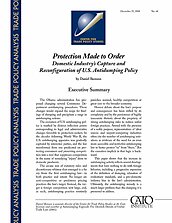The evolution of U.S. antidumping policy is marked by distinct inflection points corresponding to legal and administrative changes favorable to protection-seekers. In the decades following World War II, the U.S. antidumping apparatus was gradually captured by interested parties, and the law transformed from one predicated on protecting consumers and preserving competition into a tool that suppresses competition in the name of remedying “injury” done to domestic producers.
The arcane mix of statutory rules and discretionary whimsy that emerged is a far cry from the first antidumping law — in both practice and intent. No longer are anti-competitive or predatory pricing practices the law’s target. Instead, the target is foreign competition writ large, and, as such, antidumping practice routinely punishes normal, healthy competition at great cost to the broader economy.
Honest debate about the law’s purpose and consequences has been stifled by its complexity and by the persistence of highly inaccurate rhetoric about the propriety of strong antidumping rules to redress unfair foreign practices. Armed with the pretense of a noble purpose, representatives of labor unions and import-competing industries often cite the number of antidumping initiations as evidence of the need for an even more accessible and restrictive antidumping law to better protect “us” from “them.” But the causation implicit in that logic is backward.
This paper shows that the increase in antidumping activity reflects several developments that have nothing to do with foreign behavior, including a progressive expansion of the definition of dumping, relaxation of evidentiary standards, and a pro-domestic industry bias in the law’s administration. Ultimately, the antidumping remedy is a much larger problem than the dumping it is presumed to address.


